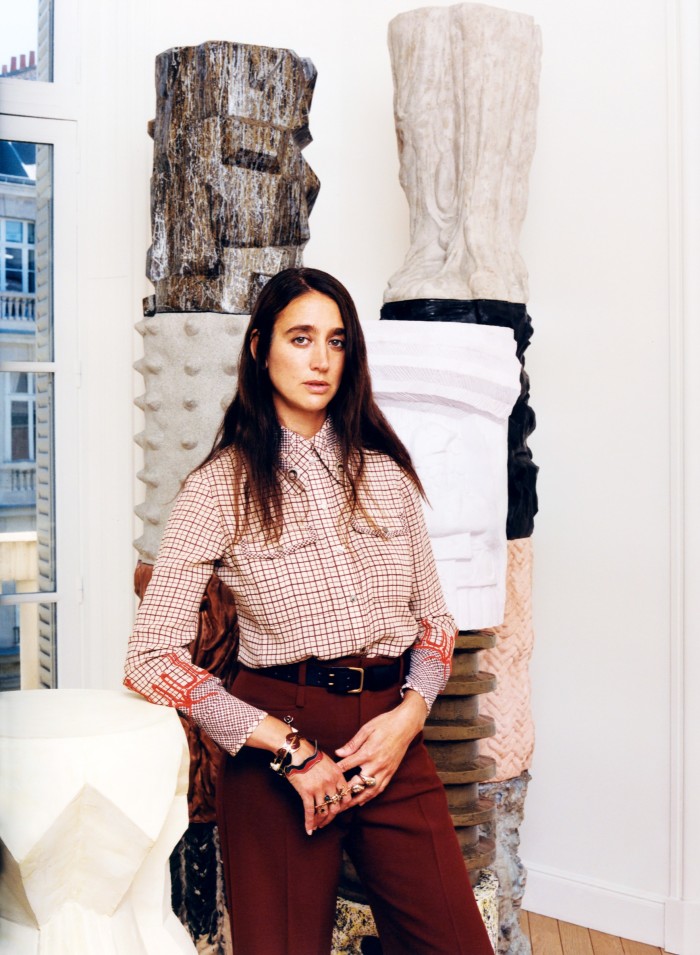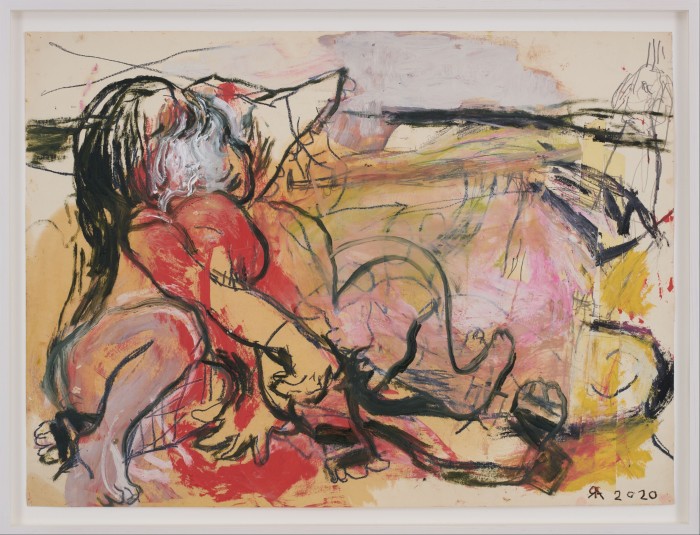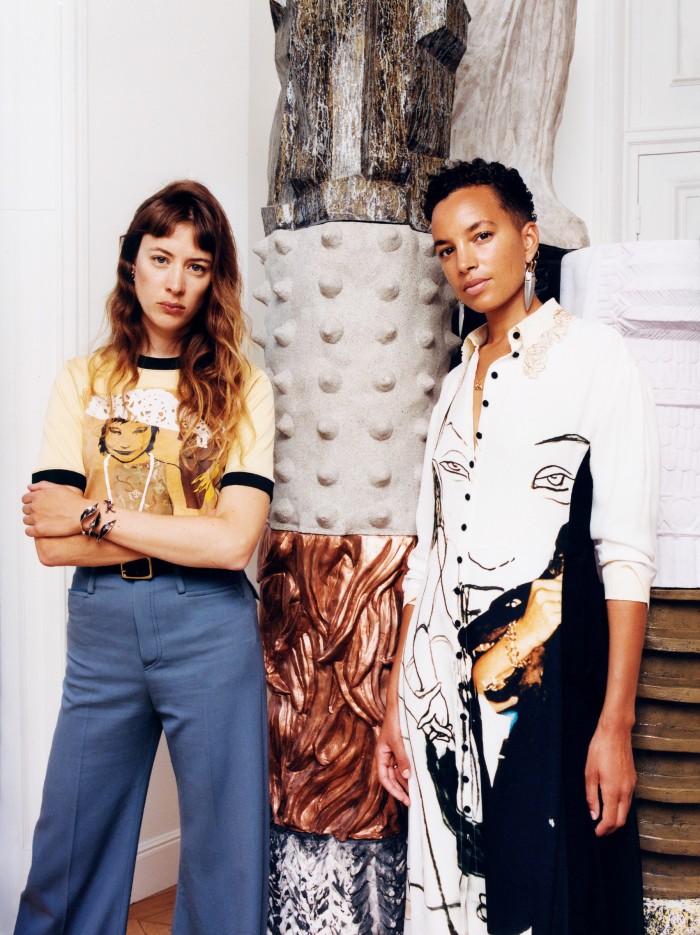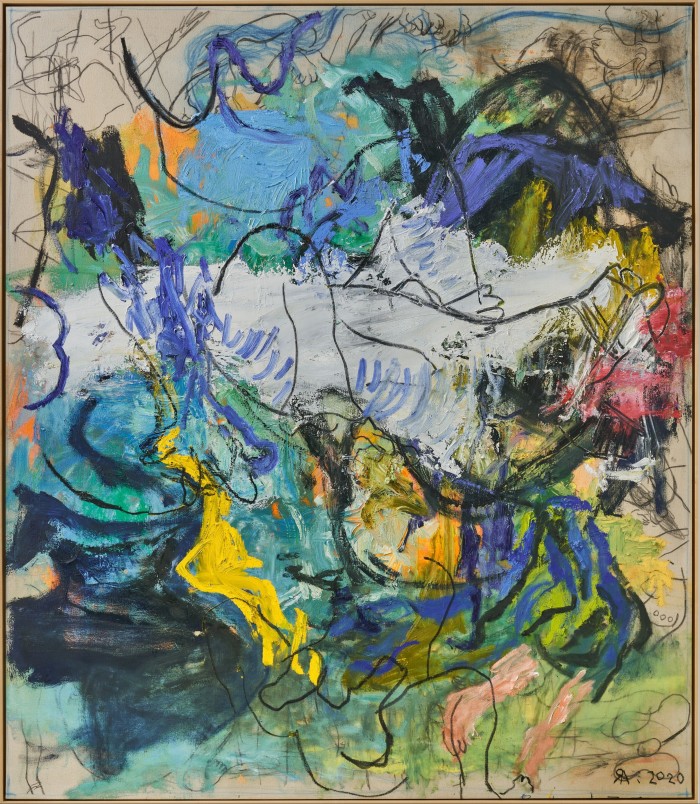The new Chloé art collective

Simply sign up to the Fashion myFT Digest -- delivered directly to your inbox.
In Zadie Smith’s 2020 collection of essays, Intimations, the author comments on how video conferencing has aestheticised our conversations, leading to a self-conscious adaptation of ourselves and our surroundings. No example illustrates this better than my call between Chloé’s creative director Natacha Ramsay-Levi and the artist Rita Ackermann. Dialling in from her studio in New York, Ackermann looks every bit the working painter: wearing a practical black vest, hair pulled back into a high bun, her chaotic, brilliantly hued works looming behind against raw particleboard walls. Ramsay‑Levi, calling from Chloé’s Paris headquarters, wears a khaki printed jacket with the sleeves bunched up and a single long earring. She’s sitting in an office stacked with books and neat piles of paper, and at one point she cracks open a window and lights up. The artist and the fashion designer: a conversation aestheticised.
The two creatives natter away like old acquaintances – which they are. “We met through Olivier [Zahm], about 10 or 15 years ago,” says Ramsay-Levi, referring to her former partner, the art director and editor of Purple, with whom she has a seven-year-old son. “But we’re also connected through ideas and art, and through other friends.” Which is how they ended up collaborating for Chloé’s autumn/winter 2020 collection, shown in Paris in February and hitting stores this month. Named after one of Ackermann’s works, If You Listen Carefully… I’ll Show You How To Dance (1995), the presentation was set among ornate gilded columns by the sculptor Marion Verboom, while a spoken-word soundtrack voiced by Marianne Faithfull filled the room. The clothes, typical to Chloé’s feminine, ’70s-inspired mood, were punctuated with the lithe, female forms that frequent Ackermann’s works.
The spark for the collaboration came after Ramsay-Levi saw her stepdaughter (Zahm’s daughter) carrying an Ackermann-decorated shopping bag. “It seemed kind of magical, because I know her work and know what she wants to say, and so I wrote to Rita to ask,” says Ramsay-Levi. Ackermann doesn’t usually say yes. “Actually, I will tell you that I’m a big ‘no’ person,” replies the artist. “But I had followed Natacha’s work from when she was working for other fashion houses, and I just always felt that there was something very touchingly feminine and powerful about her designs.”


Ackermann has always been intertwined with the fashion world. Born in Budapest, she arrived in New York in the early ’90s, at a point when the contemporary art scene that had dominated the decade prior had fizzled out to make way for a new era of artists. “The people around my age who were coming out of art schools were more interested in fashion than the art scene,” says Ackermann. “If you imagine, in the early ’90s, stylists did not exist yet. So [my friends and I], we created fashion and style together.” Members of the club included Bernadette Van-Huy, of the guerrilla art collective Bernadette Corporation, the director and artist Harmony Korine, and model and actress Chloë Sevigny, who attended Ackermann’s New York opening at Hauser & Wirth earlier this year. “It was a super-exciting time,” she says of the group’s energy, “a very powerful, collaborative art-fashion moment.”
The pieces Ramsay-Levi chose for the Chloé collection come from Ackermann’s early oeuvre, between 1994 and 2001. “What I felt about those artworks,” says Ramsay-Levi, “is the line between fragility and strength is so subtle. I think it was beautiful to have that delicateness, which is not actually delicate but strong. We wanted to show this line between vulnerability and empowerment – that is what I can feel in Rita’s drawings. I just wanted to be able to show that and pay homage to her work.”
One particular piece, Somehow New (2001), comes from Ackermann’s series The Levitation of Strong American Women, and observes the difference in dress codes between the States and Europe. “I lived in Texas for a short while, and I saw how American women communicated through their clothes and lifestyle, shopping from catalogues like Talbot magazine,” says Ackermann. “That was so strange to me because in Europe – especially in eastern Europe – we did not express ourselves with clothes. It was more a sense of expressing yourself with how you dress.”


These two opposing ideas – “the catalogue woman and a radical, RAF Baader-Meinhof woman” – collided on a canvas in the form of two prim-looking figures with carded numbers hanging from their necks. And they have found new form via Ramsay-Levi, who has transplanted the print on to a sporty jersey T-shirt and crêpe wraparound skirt. Other works appear on long dresses and on the front of the house’s Daria bags.
“When I asked Rita to collaborate, I already knew what I wanted to do with the works,” says Ramsay-Levi. “I had this vintage dress with a flag on it – I think it was a Led Zeppelin flag – that was made by a fan.” Using the piece as inspiration, Ramsay-Levi created a long, button‑down dress with an embroidered collar and printed a work of art on to the front. You might be familiar with fan art or fan fiction – this is fan fashion, if you will. “The gesture was about doing a fan dress, a message that you want to wear to be part of that community.”


The concept of building a community underpins Ramsay-Levi’s work. She has been assembling a cadre of female creatives around her since joining Chloé from Balenciaga in 2017. For autumn/winter 2020, she enlisted a handful of friends to walk in her show, including film director Deniz Gemze Ergüven, journalist Hailey Benton Gates and fashion consultant Shala Monroque, along with the standard cast of models. She also regularly collaborates with actress Sigrid Bouaziz and stylist Camille Bidault-Waddington (with whom she chaired the Hyères fashion jury in 2019) and is a long-time friend of the writer Pauline Klein. DJ, artist and model Phoebe Collings-James – photographed here with Klein and Bouaziz – is another Chloé favourite. “I think this idea of a creative community is a very feminine thing,” says Ramsay-Levi. “There is something very special in femininity and being a woman and how you can share that. I’ve got a lot of friends who I need, and that’s the love I want to show. And that makes me better and more interesting.”

While Ackermann’s style has flip-flopped between the figurative and the abstract, the nymphish female figure has been a recurring motif throughout her career – a signature that hasn’t always been simple to explain. “Back [in the ’90s], I felt like people thought I was some kind of new feminist, or maybe an antifeminist. It wasn’t clear whether what I was doing – girls freely expressing themselves – was a feminist move or whether it was antifeminism, to break down or destroy the image of a strong, powerful image of a feminist woman. But one thing that I always emphasise about my work is I do not see it categorised.”
“I think it’s exactly that,” adds Natacha. “It’s not about being feminist or not being feminist, it’s about the experience of being a woman, and femininity, in a way. It’s the possibilities of being a woman, and that was the purpose of the show as well – it was a way to say the experience of being a woman is amazing, and you can’t put it in a box. If you start to categorise it, then you put it in a box, and to me that’s antifeminist. It’s undefined femininity that is important, and I think in those early works of Rita’s, they leave space for people to imagine what they want.”
Regardless of whether she wants to categorise it as such, there is something distinctly feminist about Ramsay-Levi’s work at Chloé – both in the community of female voices that she has amplified and in the clothes she creates, which essay a soft yet assured confidence. For this latest collection, she pinned jacket lapels and sweaters with the typical hallmarks of protest. Some were mini depictions of Ackermann’s works. Others carried a more literal missive: “Girls Forward” – the title of Chloé’s fundraising campaign for Unicef. “It’s about being able to talk about yourself,” says Ramsay-Levi. “When you dress up you want to say something, but the way I feel, you want to do it in a subtle way. I think the pins were one of the ways to give messages that refer to protest, but with a very light and beautiful message.”
Weekly newsletter

Make every moment matter with
How To Spend It - your essential guide to getting the best out of life. Sign up here.
In 2012, Ackermann told The New York Times that she was through with the fashion industry and she wanted to distance herself from the world she was once tethered to. “I felt that fashion had gradually become very corporate,” says Ackermann. “In the ’90s, I was very hands-on with young stylists and fashion designers who had strong voices that you could express yourself with, but that had slowly died out. It was all about brands and labels, and I’m not a label and brand person. It just wasn’t interesting and wasn’t inspiring. Fashion should be a form of expressing yourself beyond words.” With this collaboration, she’s been reeled back in. “I wasn’t even thinking that I was going back to fashion when I thought of working with Natacha – I just knew it was going to be meaningful. But I do actually believe there is something coming back now. People are really expressing themselves again.”
Ramsay-Levi agrees. “There was a moment when things were a bit more flat and polite. But now when you look at the fashion industry, every brand and voice is more strong and specific. When you buy clothes or a bag, you want to be part of that community, but it’s not only a logo thing. It’s like a protest T-shirt – you buy it because you want to be part of that community, so it has to be meaningful. I think in that sense voices are more welcome now, because brands need voices to be able to spread a message.”
Rita Ackermann, Mama ’20 is showing at Hauser & Wirth Zürich until 18 December 2020, hauserwirth.com
Comments